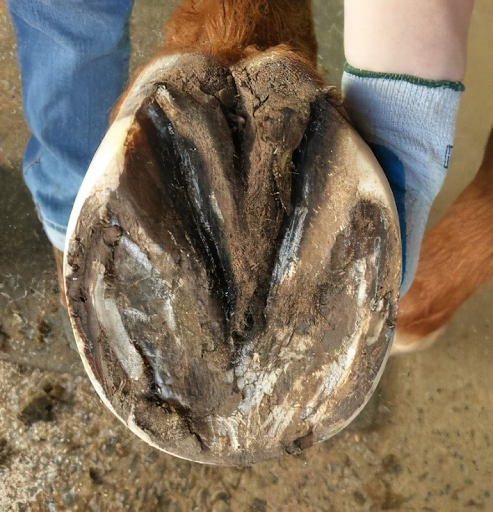What Is Thrush in Horses?
Thrush is a stinky, common hoof condition caused by bacteria in damp, dirty environments. It’s treatable with clean stalls, daily hoof picking, and topical treatments. Catch it early and keep those hooves dry.

The smelly, squishy hoof issue no one wants, and how to deal with it.
If you've ever picked up your horse’s hoof and been hit with a nasty, sour smell — chances are, you've met thrush. It's one of the most common hoof problems horse owners run into, but luckily, it's also one of the easiest to treat and prevent once you know what you're dealing with.
So, what exactly is thrush? Let’s break it down.
What Is Thrush?
Thrush is a bacterial (and sometimes fungal) infection that affects the frog of your horse’s hoof, especially in those deep grooves called the sulci (or “collateral grooves”). It causes the frog tissue to break down, get soft, and sometimes turn black or oozy. In severe cases, it can even eat into the sensitive tissue and cause lameness.
The telltale signs?
- A foul, rotting smell from the hoof
- Black or dark discharge in the grooves of the frog
- A soft or crumbly frog that may look shrunken or misshapen
- In more advanced cases, pain or tenderness when cleaning the hoof

What Causes Thrush?
Thrush loves moist, dirty, and airless environments, so hooves that stay wet or packed with manure and mud are prime targets.
Common causes include:
- Standing in wet, dirty bedding or muddy paddocks
- Unclean hooves, especially if they aren’t picked out daily
- Poor hoof balance or conformation (like deep heels or contracted heels)
- Lack of movement (horses that stand around more tend to have poor circulation in their hooves, which doesn’t help fight infection)
Thrush is opportunistic, meaning even a healthy hoof can get it if the conditions are right (or wrong, really).
How to Treat Thrush
The good news: Most cases of thrush are treatable at home, no panic required.
Here’s how:
1. Clean the Hoof Thoroughly (Every Day) Pick out the hoof carefully, especially around the frog and into those deep grooves. You may need a hoof brush to scrub away gunk.
2. Apply a Thrush Treatment There are lots of over-the-counter thrush products available (like Thrush Buster, Kopertox, No Thrush, White Lightening or Tomorrow), or even simple treatments like diluted iodine or a 50/50 mix of hydrogen peroxide and water. Some treatments are liquid, others are powder, or you may have to soak the hoof in something! Just be cautious with harsh chemicals, they can damage healthy tissue too. Ask your vet and farrier for their recommendations.
3. Keep the Foot Dry and Clean Move the horse to a dry area if possible, and make sure their stall or paddock isn't wet or filthy.
4. In Severe Cases If the infection is deep or your horse is sore, it’s best to call your vet or farrier. They may need to trim away damaged tissue or recommend a stronger treatment.
How to Prevent Thrush
An ounce of prevention really is worth a pound of Kopertox. Here’s how to keep thrush at bay:
- Pick hooves daily, especially in wet seasons
- Keep stalls clean and dry
- Avoid standing water or deep mud in turnout areas
- Work with a good farrier to ensure healthy, well-trimmed hooves with proper frog contact
- Encourage regular movement, motion helps with circulation and frog health
Final Thoughts
Thrush is annoying, but it doesn’t have to be a big deal. With regular hoof care, clean living conditions, and a little attention, most horses stay thrush-free. If your horse does get it? Don’t stress. Just roll up your sleeves and treat it early, your horse (and your nose) will thank you.
Got a thrush-busting routine you swear by? Share your tips in the TurnoutHQ community, we’re always here to swap hoof care hacks.
Sources:
AAEP (American Association of Equine Practitioners) – aaep.org Information on hoof health and infection management.
The Horse Magazine
- “Thrush in Horses: Causes and Treatments”
- “Thrush Prevention Tips for Horse Owners”
Equus Magazine – “What to Do About Thrush”
Practical Horseman – “How to Treat and Prevent Thrush”
Veterinary textbooks & farrier training manuals
- The Principles of Horseshoeing (P3) by Doug Butler and Jacob Butler
- Equine Podiatry by Andrea Floyd and Richard Mansmann

